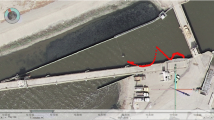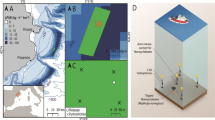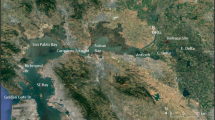Abstract
In this study, the effect of shelter acclimation on the post-release movement and putative predation mortality of hatchery-reared black-spot tuskfish Choerodon schoenleinii was examined using acoustic telemetry. We acclimated four 1-year-old fish to shelters in cages before release and compared their movements with six nonacclimated fish. Since it was not possible to compare the behavioral pattern between the former and the latter fish due to the short periods the latter fish were available to be monitored, we also compared their movements with those of large nonacclimated fish that were less likely to be preyed upon. Sixty-seven percent of the nonacclimated fish showed atypical movements before the signals ceased to be detected, a pattern that suggested a predation event had occurred, whereas none of the acclimated and large nonacclimated fish showed the atypical movements. In addition, the probability of detection cessation was about 13 times lower in the acclimated than nonacclimated fish. The signal detection patterns suggest that the acclimated fish utilized night-time shelters from the first night after release, while the large nonacclimated fish started to utilize shelters several days after release. Therefore, it is likely that the shelter acclimation enhanced the shelter utilization by tuskfish, possibly decreasing post-release predation mortality.






Similar content being viewed by others
References
Masuda R, Tsukamoto K (1998) Stock enhancement in Japan: review and perspective. Bull Mar Sci 62:337–358
Brown C, Day RL (2002) The future stock enhancements: lessons for hatchery practice from conservation biology. Fish Fish 3:79–94
Bell JD, Leber KM, Blankenship HL, Loneragan NR, Masuda R (2008) A new era for restocking, stock enhancement and sea ranching of coastal fisheries resources. Rev Fish Sci 16:1–9
Furuta S (1996) Predation on juvenile Japanese flounder (Paralichthys olivaceus) by diurnal piscivorous fish: field observation and laboratory experiments. In: Watanabe Y et al. (eds) Survival strategies in early life stages of marine resources. A.A. Balkema, Rotterdam, pp 285–294
Tsukamoto K, Kuwada H, Hirokawa J, Oya M, Sekiya S, Fujimoto H, Imaizumi K (1989) Size-dependent mortality of red-sea bream, Pagrus major, juveniles released with fluorescent otolith-tags in News Bay, Japan. J Fish Biol 35:59–69
Wada T, Yamada T, Shimizu D, Aritaki M, Sudo H, Yamashita Y, Tanaka M (2010) Successful stocking of a depleted species, spotted halibut Verasper variegatus, in Miyako Bay, Japan: evaluation from post-release surveys and landings. Mar Ecol Prog Ser 407:241–253
Fairchild EA, Howell WH (2004) Factors affecting the post-release survival of cultured juvenile Pseudopleuronectes americanus. J Fish Biol 65:69–87
Ellis T, Howell BR, Hughes RN (1997) The cryptic responses of hatchery-reared sole to a natural sand substratum. J Fish Biol 51:389–401
Kellison GT, Eggleston DB, Burke JS (2000) Comparative behaviour and survival of hatchery-reared versus wild summer flounder (Paralichthys dentatus). Can J Fish Aquat Sci 57:1870–1877
Sparrevohn CR, Stottrup JG (2007) Post-release survival and feeding in reared turbot. J Sea Res 57:151–161
Hamasaki K, Takeuchi H, Shiozawa S, Teruya K (2004) Effects of acclimation to the natural environment before release on retention rate, feeding condition and predation of hatchery-reared juveniles of the coral trout Plectropomus leopardus released on a coral reef (in Japanese with English abstract). Nippon Suisan Gakkaishi 70:22–30
Yoseda K, Asami K, Yamamoto K, Dan S (2005) Current status on broodstock management and seed production techniques in the black-spot tuskfish (Choerodon schoenleinii). In: Yu J (ed) Taiwan–Japan international symposium on marine biotechnology and its application. Academia Sinica, Taipei, pp 104–106
Wainwright PC, Bellwood DR (2002) Ecomorphology of feeding in coral reef fishes. In: Sale PF (ed) Coral reef fishes. Dynamics and diversity in a complex ecosystem. Academic Press, San Diego, pp 33–55
Kawabata Y, Okuyama J, Asami K, Yoseda K, Arai N (2008) The post-release process of establishing stable home ranges and diel movement patterns of hatchery-reared black-spot tuskfish Choerodon schoenleinii. J Fish Biol 73:1770–1782
Kawabata Y, Okuyama J, Mitamura H, Asami K, Yoseda K, Arai N (2007) Post-release movement and diel activity patterns of hatchery-reared and wild black-spot tuskfish Choerodon schoenleinii determined by ultrasonic telemetry. Fish Sci 73:1147–1154
Yamada H, Chimura M, Asami K, Sato T, Kobayashi M, Nanami A (2009) Otolith development and daily increment formation in laboratory-reared larval and juvenile black-spot tuskfish Choerodon schoenleinii. Fish Sci 75:1141–1146
Kanashiro K (1998) Morphology, and changes of distribution and food habits with growth, of late larvae and juveniles of black-spot tuskfish, Choerodon schoenleinii (Labridae), settled on seagrass beds of Okinawa Island, the Ryukyus (in Japanese with English abstract). Nippon Suisan Gakkaishi 64:427–434
Ohta I (2007) Distribution and recruitment of juvenile black-spot tuskfish Choerodon schoenleinii in seagrass beds around Yaeyama Islands (in Japanese). Ann Rep Okinawa Pref Fish Ocean Res Cent 68:249–250
Nanami A, Asami K, Chimura M (2009) Substrate selection of hatchery-reared juvenile blackspot tuskfish Choerodon shoenleinii (in Japanese). Nippon Suisan Gakkaishi 75:1073–1075
Kawabata Y, Asami K, Kobayashi M, Sato T, Okuzawa K, Yamada H, Yoseda K, Arai N (2011) Effect of shelter acclimation on the post-release survival of hatchery-reared black-spot tuskfish Choerodon schoenleinii: laboratory experiments using the reef-resident predator white-streaked grouper Epinephelus ongus. Fish Sci 77:79–85
Fairclough DV, Clarke KR, Valesini FJ, Potter IC (2008) Habitat partitioning by five congeneric and abundant Choerodon species (Labridae) in a large subtropical marine embayment. Estuar Coast Shelf Sci 77:446–456
Thorstad EB, Uglem I, Arechavala-Lopez P, Økland F, Finstad B (2011) Low survival of hatchery-released Atlantic salmon smolts during initial river and fjord migration. Boreal Env Res (in press)
Mitamura H, Arai N, Mitsunaga A, Yokota T, Takeuchi H, Tsuzaki T, Itani M (2005) Directed movements and diel burrow fidelity patterns of red tilefish Branchiostegus japonicus determined using ultrasonic telemetry. Fish Sci 71:491–498
Yokota T, Mitamura H, Arai N, Masuda R, Mitsunaga Y, Itani M, Takeuchi H, Tsuzaki T (2006) Comparison of behavioral characteristics of hatchery-reared and wild red tilefish Branchiostegus japonicus released in Maizuru Bay by using acoustic biotelemetry. Fish Sci 72:520–529
Arendt MD, Lucy JA, Evans DA (2001) Diel and seasonal activity patterns of adult tautog, Tautoga onitis, in lower Chesapeake Bay, inferred from ultrasonic telemetry. Environ Biol Fish 62:379–391
Kawabata Y (2010) Studies on the behaviour and ecology of hatchery-reared black-spot tuskfish for its optimal release strategies. PhD Dissertation, Kyoto University, Kyoto
Kleinbaum DG, Klein M (1996) Survival analysis: a self-learning text. Springer, New York
Kawabata Y, Okuyama J, Asami K, Okuzawa K, Yoseda K, Arai N (2010) Effects of a tropical cyclone on the distribution of hatchery-reared black-spot tuskfish Choerodon schoenleinii determined by acoustic telemetry. J Fish Biol 77:627–642
Masuda R, Ziemann DA (2003) Vulnerability of Pacific threadfin juveniles to predation by bluefin trevally and hammerhead shark: size dependent mortality and handling stress. Aquaculture 217:249–257
Yamashita Y, Nagahora S, Yamada H, Kitagawa D (1994) Effects of release size on survival and growth of Japanese flounder Paralichthys olivaceus in coastal waters off Iwate Prefecture, northeastern Japan. Mar Ecol Prog Ser 105:269–276
Miyazaki T, Masuda R, Furuta S, Tsukamoto K (1997) Laboratory observation on the nocturnal activity of hatchery-reared juvenile Japanese flounder Paralichthys olivaceus. Fish Sci 63:205–210
Kawabata Y, Okuyama J, Asami K, Yoseda K, Arai N (2009) Diel behavioral pattern of hatchery-reared black-spot tuskfish determined by acoustic telemetry in the natural environment and video observation in a fish tank. In: Arai N (ed) Proceedings of the 4th international symposium on SEASTAR2000 and Asian bio-logging science. Kyoto University, Kyoto, pp 69–72
Holbrook SJ, Schmitt RJ (2002) Competition for shelter space causes density-dependent predation mortality in damselfishes. Ecology 83:2855–2868
Thompson AR (2005) Dynamics of demographically open mutualists: immigration, intraspecific competition, and predation impact goby populations. Oecologia 143:61–69
Buchheim JR, Hixon MA (1992) Competition for shelter holes in the coral-reef fish Acanthemblemaria spinosa Metzelaar. J Exp Mar Biol Ecol 164:45–54
Robertson DR, Sheldon JM (1979) Competitive interactions and the availability of sleeping sites for a diurnal coral-reef fish. J Exp Mar Biol Ecol 40:285–298
Acknowledgments
We thank T. Takebe, N. Hirai, T. Kurihara, A. Nanami, G. Suzuki, S. Arakaki, and other members of the Ishigaki Tropical Station, Seikai National Fisheries Research Institute, Fisheries Research Agency, for research assistance, valuable comments, and encouragement. We also thank I. Ohta at the Okinawa Prefectural Fisheries and Ocean Research Center for providing valuable information on the black-spot tuskfish and white-streaked grouper, and R. Masuda at the Maizuru Fisheries Research Station, Kyoto University, for providing helpful comments on determining experimental procedures. We wish to express appreciation to J. Okuyama, H. Kamihata, T. Hashiguchi, and other members at the Graduate School of Informatics for their research assistance and constructive comments. H. Mitamura, G.N. Nishihara, M. Sano, and anonymous reviewers provided valuable comments on the manuscript. This research was supported by a Grant-in-Aid for JSPS fellows to Y.K. (20-2242), Kyoto University Global COE Program: Information Education and Research Center for Knowledge-Circulation Society, and a grant from the Fisheries Research Agency, Japan.
Author information
Authors and Affiliations
Corresponding author
Rights and permissions
About this article
Cite this article
Kawabata, Y., Asami, K., Kobayashi, M. et al. Effect of shelter acclimation on the post-release movement and putative predation mortality of hatchery-reared black-spot tuskfish Choerodon schoenleinii, determined by acoustic telemetry. Fish Sci 77, 345–355 (2011). https://doi.org/10.1007/s12562-011-0351-x
Received:
Accepted:
Published:
Issue Date:
DOI: https://doi.org/10.1007/s12562-011-0351-x




